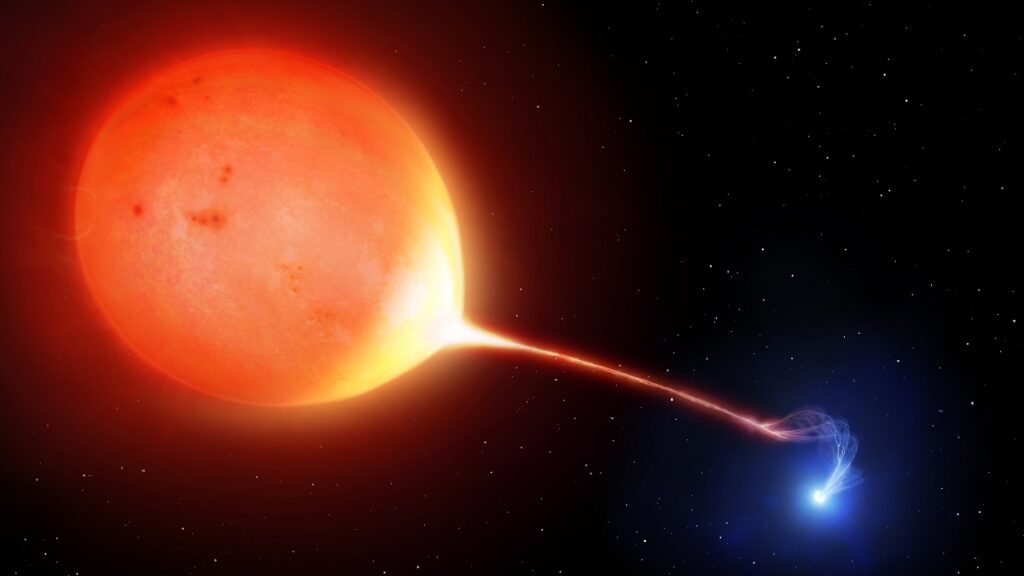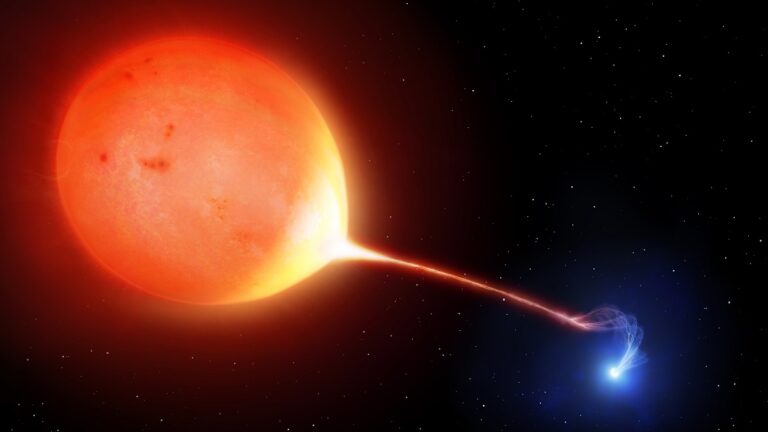Binary stars with the shortest orbit discovered locked in a “cataclysmic” embrace.
The two stars orbit each other every 51 minutes and confirm a long-debated theory about whether this could even be possible.
Astronomers have found the binary star system with the shortest orbit ever seen.
The system is thought to belong to a unique category of binary systems called “cataclysmic variables.” One star in each of these systems, around the size of our sun, revolves around a white dwarf, the hot, dense core of a star that has burnt out.
Like our sun, over half of the stars in the Milky Way are solitary. The remaining ones come in groups of two or more and revolve around one another. Some star systems might fit between Earth and the moon since these orbits are frequently so close together.

Over the course of billions of years, the two stars move toward one another, becoming cataclysmic binaries. Beginning to accrete, or take material from the other star, is the denser white dwarf. This process can occasionally produce massive bursts of light that were formerly thought by astronomers to be the product of an unidentified apocalypse.
The newest system has been given the moniker ZTF J1813+4251. The system is located in the Hercules constellation around 3,000 light years away from Earth. The stellar pair’s orbit, at 51 minutes, is the shortest catastrophic variable orbit discovered. Nature published a report on the discovery.
The scientists were able to properly quantify the characteristics of each star as they were obscured by one another.
The scientists were able to simulate the system’s evolution using their calculations. They come at the conclusion that the stars would move toward one another, circle each other every 18 minutes for 70 million years, before starting to grow and drift away.
The sun-like star has lost much of its hydrogen atmosphere, eventually decreasing to its largely dense, helium-rich core, while the other stars are in a transitional phase.
First author Dr. Kevin Burdge from MIT adds, “This is a unique situation where we captured one of these systems in the midst of flipping from hydrogen to helium accretion. It was long contested whether these objects’ orbits might get so brief as to produce observable gravitational waves, but people expected they would eventually convert to ultrashort orbits. This finding disproves that.
The Zwicky Transient Facility (ZTF), a study that makes use of a camera mounted on a telescope at the Palomar Observatory in California, found the new system among a massive catalog of stars.
Each of the more than 1 billion stars in the sky has been captured in more than 1,000 photos, allowing researchers to track how bright each star changes over the course of days, months, and years.
Burdge searched over the data in search of indications of ultrashort orbits, such as jarring light bursts and gravitational waves. According to Burdge, “gravitational waves are enabling us to understand the cosmos in a whole new way.”
In response, Burdge says, “this thing showed up, where I saw an eclipse happening every 51 minutes, and I said, OK, this is clearly a binary.”
The scientists concentrated on the new binary using the Gran Telescopio Canarias in Spain and the W.M. Keck Observatory in Hawaii. They were able to precisely quantify the attributes of the stars thanks to the “clean” images of the stars crossing each other.
With a diameter 1% larger than our sun’s and half its mass, they discovered that the initial object was probably a white dwarf. At a tenth the size and mass of the sun, the second object was a sun-like star that was nearing the end of its existence (about the size of Jupiter).
However, the sun-like star shouldn’t be able to circle that swiftly.
The sun cannot fit into an orbit less than eight hours, but this one star resembled the sun. What is going on? Burdge enquired? Then, Budge and colleagues realized that this had to be a catastrophic variable, so supporting a long-held view.
The sun-like star is reduced to its core, but it is still massive and heavy enough to maintain the dead star in a very tight orbit.
This is a unique method, Burdge declares. “We got doubly lucky to find a system that addresses a huge open issue, and is one of the most exquisitely behaving catastrophic variables known,” says the researcher.
Originally published by Cosmos as Binary stars with the shortest orbit discovered locked in a “cataclysmic” embrace
Do not forget to share your opinion with us to provide you with the best posts !




0 Comments